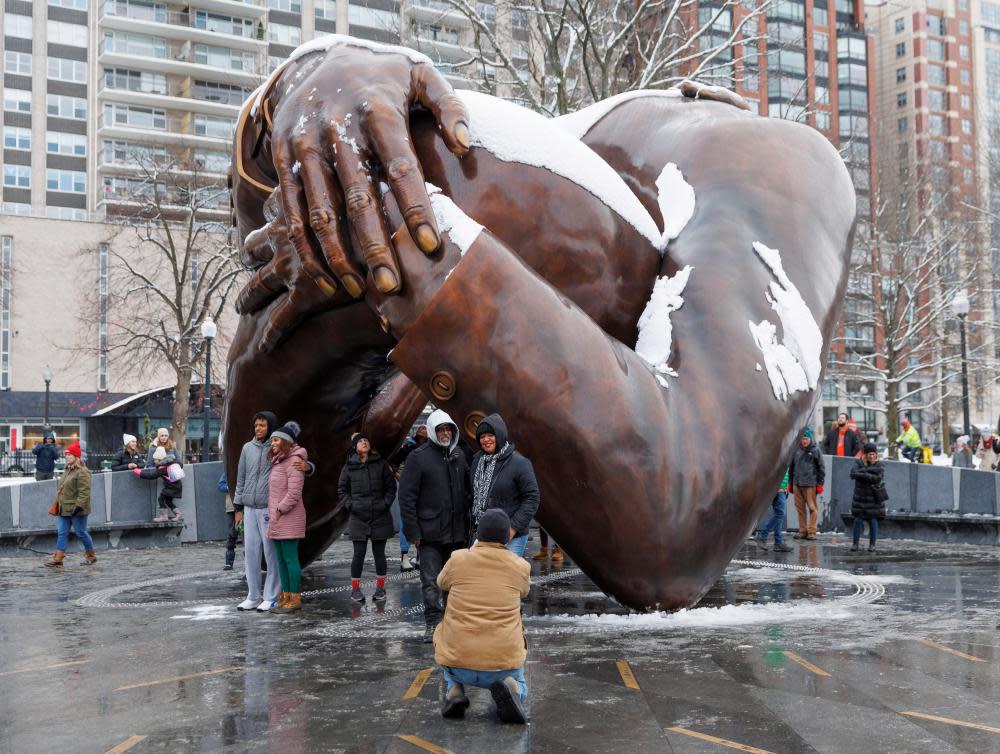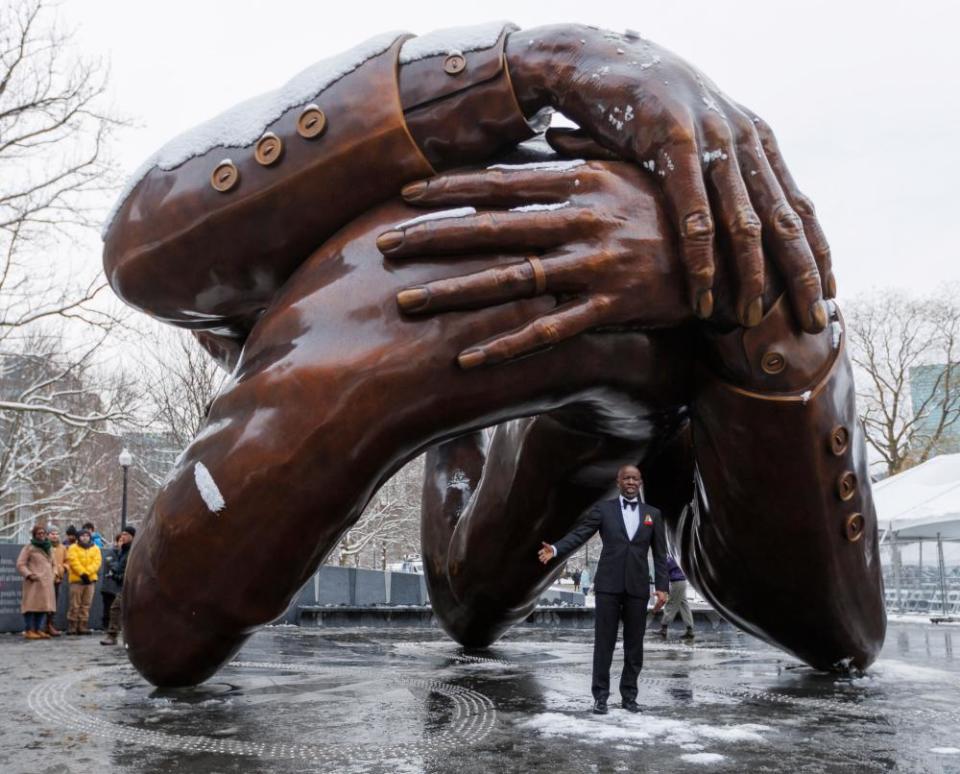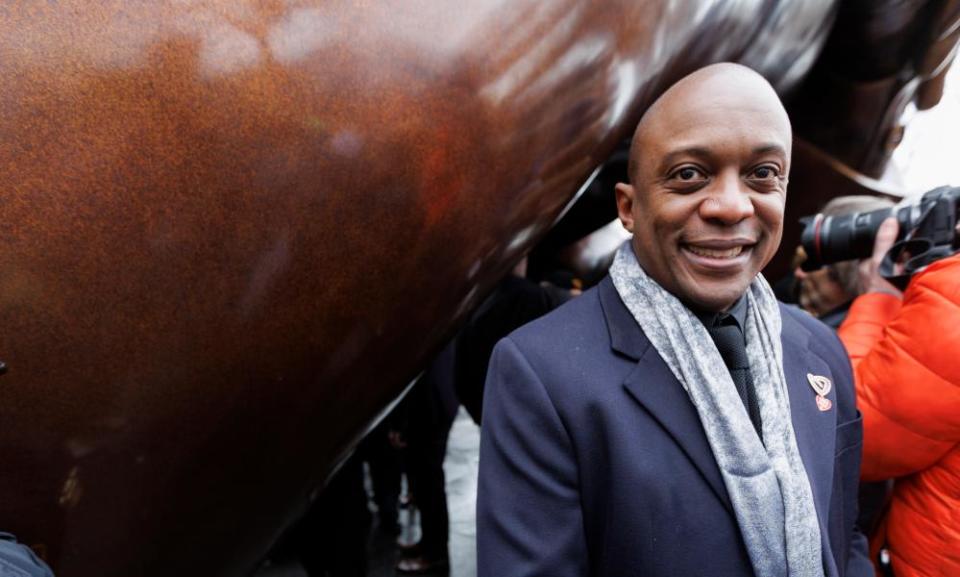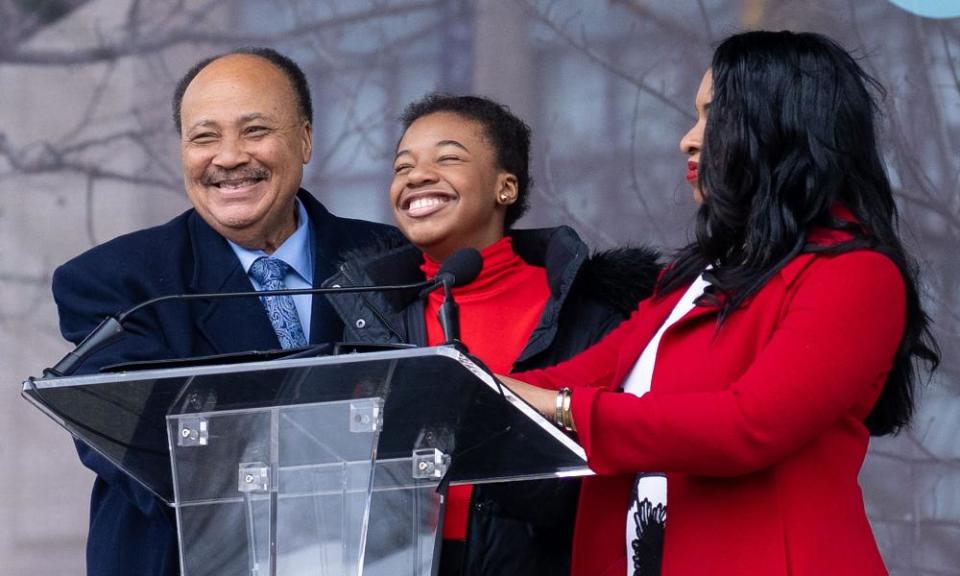‘It’s a strange moment we live in’: MLK sculptor on backlash to monument

- Oops!Something went wrong.Please try again later.
- Oops!Something went wrong.Please try again later.
- Oops!Something went wrong.Please try again later.
- Oops!Something went wrong.Please try again later.
The 22ft-tall, 19-ton bronze sculpture unveiled last Friday in Boston, The Embrace, depicts two pairs of arms wrapped in a hug: those of Martin Luther King Jr and his wife, Coretta Scott King. It’s a detail pulled from a famous photo of the couple embracing – and to the artist, Hank Willis Thomas, a representation of how their love catalyzed a mass movement that changed the world.
Related: The unlikely bond between Julia Roberts and Martin Luther King Jr
The sculpture was installed near where King led 22,000 people at a 1965 Freedom Rally – on land that was once part of a black neighborhood, now gone, that had been one of the oldest in the country. The significance wasn’t lost on guests at the unveiling, who included participants in the civil rights movement, some nearly 100 years old. Many onlookers were in tears, organizers say. And the piece drew praise from the Kings’ son Martin Luther King III, who told CNN that the “artist did a great job”.
Yet some online viewers of the sculpture had a different reaction: photographs taken from certain angles made one of the civil rights leaders’ arms look like a penis, they said. The comedian Leslie Jones joked that the sculpture looked like the late civil rights leader performing a sex act on his wife.
If this was just about an optical illusion, the story might have ended there. But the conflict almost immediately took a political turn after the sculpture was blasted by an unexpected source: the Oakland activist Seneca Scott, a former Bay Area labor organizer and a cousin of Coretta Scott King.
In a short essay published in Compact magazine the morning after the unveiling, Scott highlighted the phallic comparisons before calling the sculpture an “egregious example of the woke machine’s callousness and vanity” that would bring “few, if any, tangible benefits to struggling black families”. Statues like these, he added, “are part of the same performative altruism and purity pageants that are mainstays of the woke left”.

The broadside earned him a headline in the conservative New York Post, and a three-minute live interview with the Fox News host Tucker Carlson, who broke into a grin as Scott accused the sculpture of wasting public funds and mocking people struggling to afford groceries. “That’s exactly right,” Carlson replied. “It’s not art, it’s a middle finger.”
Just days into its public life, The Embrace was becoming a kind of political litmus test. But what do its creators think?
“It’s a strange thing, the moment that we live in, that we are more inspired to talk about silly things than something as serious as the legacy of Dr Martin Luther King,” Thomas said on Wednesday. Thomas was speaking to me on a Zoom call alongside other non-profit workers of color who helped realize the project. The mood was subdued, even a little tense.
He objected to a question about the piece’s conservative critics: “Conservative and liberal are reductive terms that are divide-and-conquer strategies,” he said. “And that’s part of the issue this piece is addressing – that is, can we embrace one another?” He declined to respond to Scott: “I don’t feel like it other than sending Seneca love and gratitude for highlighting The Embrace.”

Thomas explained he had originally trained as a photographer, which sparked a fascination with the context behind famous civil rights photographs: what was included in the frame and what was left out? He explored the hidden details lurking within the image that could make a photo unexpectedly powerful. That’s why he focused on the Kings’ arms – “an embodiment of the ‘beloved community’”, a term the civil rights leader often used to describe a just society where everyone’s needs could be met.
He conceded there was some irony in how online viewers saw the piece so differently. “That’s what my work is about: photographs distort the truth. Had that photograph been taken from a different angle, I might have seen something different.”
But he and others who helped realize the project strongly rejected any characterizations of The Embrace as empty gesture. Imari Paris Jeffries, the director of Embrace Boston, the non-profit formed in 2018 to fund the statue, said the artwork was fully paid for by private donations, not taxpayer money. Their goal was to not only use the sculpture as a visual reminder of justice, but as a catalyst for concrete local change: since 2020, the group has distributed $1m to the Twelfth Baptist church, the historic abolitionist church where the Kings met and a relief center during the pandemic; $370,000 in grants to dozens of community non-profits and social justice efforts; and $25,000 to groups organizing Juneteenth activities – with more giving planned in the future.

The hope, Jeffries said, was to get beyond a zero-sum mindset “that when things happen where people of color receive something, they think something else was taken away – versus an abundance approach, where this happened, and then this happened also”.
As for the backlash to the statue, “I’m not bothered by it,” he said. “We expected as activists and organizers that there’s always going to be detractors from the movement. I think about Mrs King’s quote, that the beloved community is about not holding bitterness when there’s disagreement.”
Scott, for his part, told the Guardian his reaction had come from a place of grief.
There was the grief that Coretta’s face wasn’t included: “She was particularly beautiful. She had a regal, iconic face.” Then there was his resentment over non-profits, after working at a union he felt prioritized political ideology over its own rank and file. He looked up Embrace’s “slick website” – “and I know people who come from DEI [diversity, equity and inclusion] specialties in corporate America when I see it.” And he felt angry.
So he fired off an article he knew would get a rise out of people. “This is why I use words like ‘woke’: every time you write an article, editors ask me to use more ‘wokes’ in the article. You can say ‘progressive’, but they’ll change it to woke, because they know the more ‘wokes’ [are in] an article, the more people love them. It’s a buzzword that gets clicks.”
But that was four days ago: “When I wrote that, I was in the anger part of grief. Now I’ve accepted the grief.” He has also discovered that the sculpture wasn’t paid for with public funds as he’d assumed, which makes him “not nearly as upset”.

Scott’s voice grew animated as he described his community work in Oakland. He’s particularly passionate about creating “parallel structures” outside of mainstream politics to develop sustainable local farming – what he calls “soil-based economies”.
His passion for Oakland was reminiscent of Embrace’s feelings for Boston, and I wondered if there hadn’t simply been a misunderstanding. So I asked Scott if he could imagine connecting with Embrace, and he said yes.
“People are going to forget about the statue in a week,” he said. “So what could happen in a week or two is that our organizations, from coast to coast, could find some common ground and maybe be able to help each other create better neighborhoods.”
I asked Jeffries if he’d like to connect with Scott, and he immediately agreed. “I think sometimes the way that structural racism works, it pits leaders and families against each other with partial information to sensationalize something, versus bringing together people who probably have a lot of common ground,” he said. “But all of us have a way in which Dr King has influenced us. And it’d be great if Seneca came to Boston, and we could show him the memorial and he could see it for himself.”

